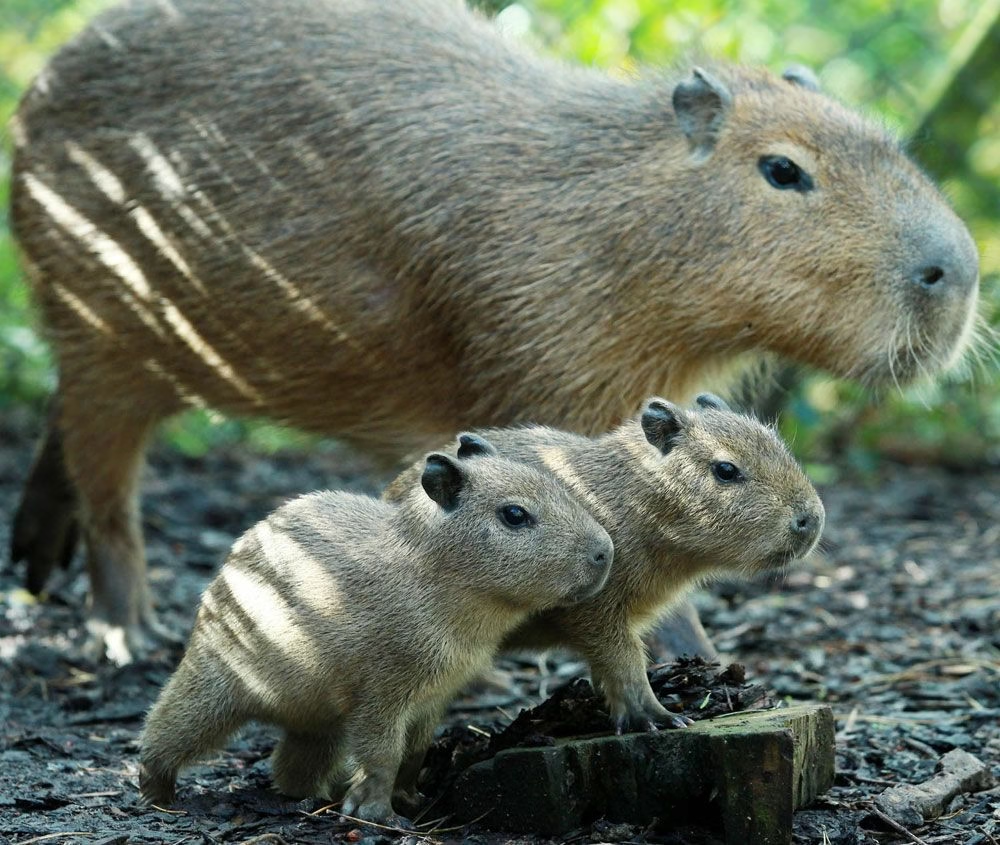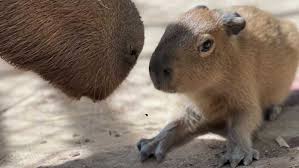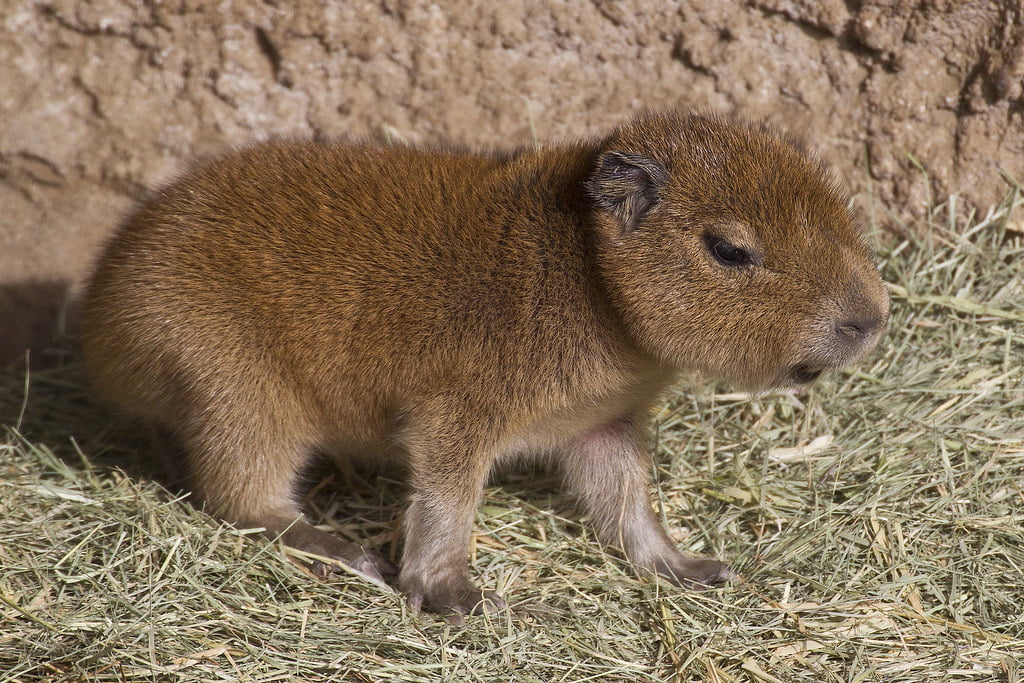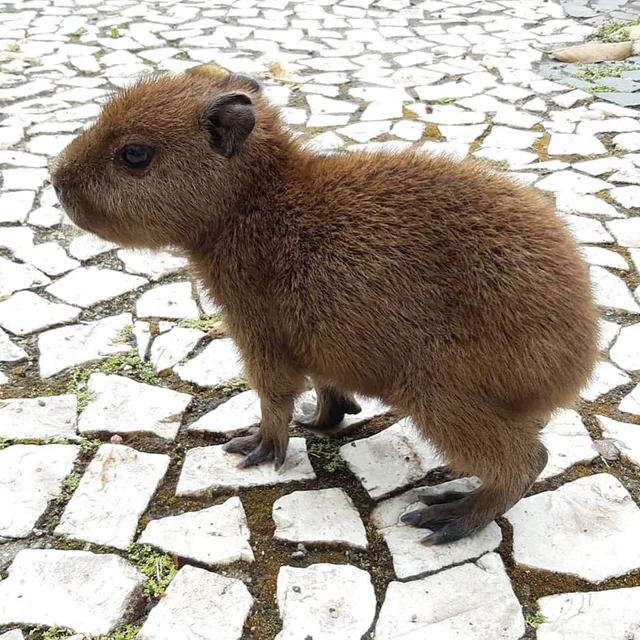Baby Capybara – the world’s largest rodent! These South American natives weigh up to 66 kg and can hold their breath underwater for five minutes. They lead social lives, living in herds and have webbed feet. Capybaras are highly adaptable and can be found in rivers, swamps, forests, and grasslands – they play a vital role in the ecosystem! Plus, they’ve been domesticated in some parts of the world for their meat and fur. Hunting them is illegal, so don’t miss out on learning more about these fantastic creatures and their contribution to biodiversity.
Cute and cuddly, capybaras may look harmless, but they’re expert swimmers and nibblers!
Characteristics of Baby Capybara
To understand the traits of a baby canto, delve into the capybara’s traits. These two sub-sections highlight the distinct features that make baby capybaras fascinating animals.
Appearance
Baby capybaras have a unique look, like mini-adults. They have dark brown fur, an elongated head, small beady eyes, and webbed feet with sharp claws. At birth, they are only They, but they already have at birth the same features as grown-ups.
Adult capybaras can each reach up to 4 feet and weigh 140 pounds, but baby capybaras can quickly adapt to water. They can swim within hours of birth and stay underwater for minutes, using their webbed feet to move around.
If you want to keep a baby capybara as a pet, you must provide them with enough space for playtime and exercise. It’s important to trim their claws regularly to prevent any injuries. Also, freshwater ponds or big bodies of water are essential for their health and happiness.
Behavior
Capybara Pup Actions!
Baby capybaras are social creatures who love to be in packs or herds. They are gentle around people and other animals, making them great companions. These little critters are active early in the morning and nap all day. To pallies anything and barking.
The pack raises capybaras and herds them. All members help the young if needed, giving them a strong sense of community and intelligence.
It’s believed that capybaras have been kept as pets since pre-Columbian times in South America. People appreciated their docile temperament and meat. They are still kept as pets or livestock today. They are often referred to as “miniature water pigs“!
Habitat and Diet of Baby Capybara
To understand the habitat and dietary baby capybaras’s baby capybaras, you need their natural habitat and dietary requirements. Their nutritional habitat is crucial to their overall well-being, while their dietary needs ensure sufficient nutrients and sustenance. So, let’s dive into the sub-sections of the natural habitat and nutritional needs of baby nutrition to discover more about their living and eating habits.
Natural Habitat
The habitat of infant capybaras is critical to their survival. These animals can live in many natural environments, such as grasslands, savannas, wetlands, and forests, all with access to water sources.
Their body hair and webbed toes make them great swimmers. Plus, their nostrils are on top of their snouts- which is excellent for swimming comfort. Even baby capybaras can benefit from these features.
See the table below for more details on the capybara’s habitat:
| Environment Type | Habitat Attributes |
|---|---|
| Grasslands | Open areas |
| Savannas | Trees and shrubs |
| Wetlands | Access to water |
| Forests | Dense tree canopies |
Female caps wean their babies from 4 to 7 months old. After that, the family group introduces them to aquatic habitats. Baby caps can move around 24 hours after birth, but exploring sites beyond resting takes a few weeks.
Unlike other rodents, capybaras are diurnal and often graze during the day. During high water seasons, or when the grass is over a meter high, they are forced to move out into drier areas. In Brazil’s Pantanal, wild capers live in harmony with jaguars!
Don’t be deceived by their cute faces- baby caps have a huge appetite!
Dietary Needs
Capybaras are herbivorous and need a high-fiber diet. This includes 16% crude fiber and 14% protein. To meet these requirements, baby capybaras need:
- grass/hay (high-fiber)
- fresh veggies (vitamins & minerals)
- fruits (carbohydrates)
- cucumber/pumpkin (water content)
In addition, young capybaras need milk from their mother. When they start eating solid food, introduce them to various veggies and fruits for vitamins and minerals.
Note: Improper feeding can lead to health issues, even metabolic bone disease in captive capybaras (Journal of Zoo and Wildlife Medicine).
Fun fact: Capybaras have 20 teeth – just like humans! They can also weigh up to four pounds at birth.
Reproduction and Lifecycle
To understand the reproduction and lifecycle of baby capybaras, you need to take a closer look at their mating and gestation process and how the birth and care of these animals differ from other species.
Mating and Gestation
Mating is only the start of the reproductive process in animals. After mating, a fertilized egg develops matingops into offspring in the female’s body. Factors like environment and genetics affect this process, which varies among species.
Through experimentation, the embryo grows vital organs and structures. It gets nutrients from the placenta or yolk sac and eliminates waste through the mom’s bloodstream or particular organs.
Kangaroos have pouches, and birds have parental care, two unique prenatal adaptations. The University of Vienna discovered that some sea slugs can reproduce both sexually and asexually depending on the environment and cues. So they can adapt to certain conditions.
Bringing a baby into the world may seem intimidating. But there is an instruction manual to help you out – written in a strange language!
Birth and Care
Giving birth and nurturing a newborn is essential for many species. Offspring receive care from parents, siblings, or social groups. Newborns need warmth, protection, and nourishment to grow. Care methods vary depending on resources, predators, and the environment.
Some animals, like sharks, snakes, and reptiles, hatch independently. But mammals, like elephants and whales, nurse their young with milk to give them nutrients. Social animals, like primates and penguins, have both parents caring for the young.
To ensure proper care, create a warm environment that replicates natural conditions. Provide frequent feedings for adequate nutrition. A vet should also check up on newborns for health issues.
Newborns need attention during their early stages for optimal growth and development. Knowing each species’ unique needs is critical to survival and healthy communities.
Threats to Baby Capybara
It’s crucial to be aware of your baby capybara’s various threats to safeguard it from potential harm. This article will discuss the two primary categories of threats to baby capybaras: natural and human threats.
Natural Threats
Capybara’s Natural Predators
Capybaras are herbivorous animals with natural habitats. Other herbivorous animals include jaguars, anacondas, and caimans. These animals rely on capybaras as their primary food source. Humans also hunt them for meat and skin.
Jaguar’s ambush near the water. Caimans lurk underwater. Anacondas use their powerful coils to suffocate capybaras before swallowing them. Capybaras form groups near open waters, which makes them visible to predators.
Mothers keep watch and hide them in dense vegetation to protect baby capybaras. Being good swimmers gives them an edge – they can quickly escape predators.
It’s essential to preserve their habitats. That way, we can ensure their safety and maintain the balance with nature. People who want to turn baby capybaras into fashion accessories are fur-rocious!
Human Threats
Human activities are now jeopardizing the safety of baby capybaras. Deforestation, wildfires, and land development can lead to habitat loss. Hunting and illegal trade of these animals for exotic pets puts their survival in danger. Ingestion of plastic waste in their natural habitats can cause health issues.
We need to act fast to protect these vulnerable creatures. Juggling must be punished, and conservation efforts must be promoted through community awareness campaigns.
Let us show empathy for nature. Protect its resources and preserve life by safeguarding delicate species such as baby capybaras. Perhaps their cuteness will go viral and help them gain enough attention for conservation.
Conservation Efforts for Baby Capybara
Protection and management strategies must be in place to ensure the survival and well-being of baby capybaras. Protection and management organizations are also crucial in the conservation efforts of baby capybaras. This part will briefly introduce you to the sub-sections ‘Protection and Management Strategies’ and ‘Role of Zoos and Conservation Organizations.’
Protection and Management Strategies
Protections have been put in place for baby capybaras’ welfare. These are implemented to keep their natural habitats, avoid unnecessary interference, and ensure proper living conditions.
The table below details these strategies:
| Protection and Management Strategies | Actual Data Used |
|---|---|
| Habitat Conservation | Saving wetlands, forests, and grasslands |
| Avoidance of Human Intervention | People interaction is restricted to specific viewing areas |
| Provision of Optimal Living Conditions | Access to food and water |
Also, laws control hunting activities in the capybaras’ habitat to reduce hunting pressure.
A top tip: Monitor the strategies’ outcomes often so any changes can be made quickly. Zoos and conservation organizations play a significant role in ensuring the safety of baby capybaras while their parents are away.
Role of Zoos and Conservation Organizations
Organizations fighting for the survival of baby capybaras are making tremendous efforts! Zoos and conservation organizations are essential for breeding, raising, and releasing animals into the wild. They provide a safe space with plenty of resources and social interaction, which helps develop survival instincts in thrganpups’ survival. They also restore degraded habitats, maintain vegetation, and educate the community on wildlife conservation.
Zoos often exhibit adult capybaras to teach visitors about preservation. Value-based messaging can increase knowledge and promote positive actions toward preserving baby capybaras. Plus, research programs examining genetics and disease prevention can provide valuable info for management measures.
Collaboration between conservation organizations is necessary. Knowledge-sharing can boost communal interests and improve science development to aid the well-being of baby capybaras. As more people recognize their cuteness and social bondings, they become symbols of resilience for ever-growing communities worldwide.
It’s up to us if future generations can enjoy the many wonders of biodiversity. So, don’t be a party pooper, protect the Capybara trooper!
Importance of Protecting Baby Capybara Population
We must protect the baby capybara population for their survival. Threats such as habitat loss, predation, and hunting can be dangerous. We must conserve their habitats, regulate hunting, and educate people who come in contact with them.
It’s imperative to teach the youth and raise awareness about capybaras. Conservationists must inform hunters and farmers about these strategies to avoid unintentional harm to these animals.
Tourists must understand how to interact with capybaras ethically without disrupting their natural behavior. This will have a tremendous positive impact on the local economy through increased tourism.
Supporting conservation organizations that work to protect and rehabilitate native species will help ensure safe habitats while officials hold responsible parties accountable.
By practicing these steps together, we can reduce threats to baby capybara populations and improve conditions for animals and humans.
Frequently Asked Questions
Q: What is a baby capybara?
A: A baby capybara is the young offspring of a capybara, a large and social rodent native to South America.
Q: What do baby capybaras eat?
A: Baby capybaras typically nurse from their mothers for the first few months, but they can start eating grasses and other vegetation as early as one week old.
Q: How big do baby capybaras get?
A: Baby capybaras can weigh between 2 and 4 pounds at birth and grow up to 1.3 meters (4 feet) in length and up to 66 kg (145 lbs) as adults.
Q: How do baby capybaras communicate with their parents and siblings?
A: Baby capybaras use various vocalizations to communicate with their family members, including purrs, grunts, whistles, and barks, to communicate with the of a baby capybara.
A: Capybaras are known to live up to 8-10 years in the wild and up to 12 years in captivity.
Q: Are baby capybaras legal to keep as pets?
A: The laws concerning keeping capybaras as pets vary depending on the country and state. However, it is generally not recordkeeping them as pretend to keep them as pets recommended space and interaction because they are mammals kind.


.jpg)


